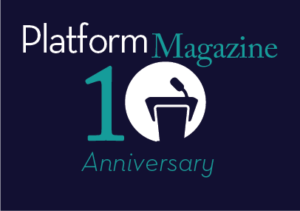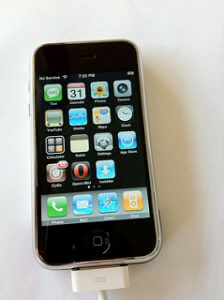10 Years of Platform, 10 Years of PR
Published on June 16, 2017, at 7:35 a.m.
by Allison Morris.
 A lot can change over the course of 10 years. In 2007 I had braces and shopped at Aeropostale, which now is closing stores nationwide. My parents had just given me a flip phone that took subpar pictures and sent limited text messages each month. That same year, Platform Magazine was just taking off. In honor of the approaching 10-year anniversary of the publication, here’s a review of some top stories over the past 10 years.
A lot can change over the course of 10 years. In 2007 I had braces and shopped at Aeropostale, which now is closing stores nationwide. My parents had just given me a flip phone that took subpar pictures and sent limited text messages each month. That same year, Platform Magazine was just taking off. In honor of the approaching 10-year anniversary of the publication, here’s a review of some top stories over the past 10 years.
2007: Welcome to the world, iPhone.
For millennials it’s difficult to remember our lives before the iPhone. How exactly did we do it? In his famous keynote at Macworld 2007, Steve Jobs described the iPhone as “a revolutionary mobile phone and a breakthrough internet communications device.”
Since its inception, the iPhone has lived up to Jobs’ description and become so much more. Remember those annoying “there’s an app for that” commercials? There truly is an app for everything under the sun, and we have iPhone to thank.

2008: Coffee, donuts and online ads
The financial crisis was heating up, and Dunkin’ Donuts was busy working on an ad with Rachael Ray. Little did the company know, an accessory of Ray’s would cause a fuss over the ads.
In the online advertisement, Ray is pictured wearing a scarf that, to many, resembled a kaffiyeh, the traditional Arab headdress. Critics of the ad claimed that the “scarf” was symbolic of Islamic terrorism, while others claimed wearing the headdress in such a manner was disrespectful to Islamic culture.
Receiving negative reviews from both sides, Dunkin’ Donuts had to do what it had to do in the face of controversy. Just weeks after the ads appeared on the internet, Dunkin’ Donuts pulled them.
2009: The Facebook craze
A lot of things happened with Facebook in 2009. The social media outlet rewrote its privacy rights, claiming it owned anything you posted to the site. People panicked, rightfully so. With online participation comes online responsibility. Facebook users were awoken to the fact that they needed to be just as careful online as they were in real life, so to speak. Facebook is a big, big world after all, and a powerful one at that.
With the death of Michael Jackson the same year, Facebook users flocked to the site to share and discuss the news of the king of pop’s passing. A month after his death, his Facebook fan page became the first to reach 10 million likes, passing President Obama’s number of likes at the time by close to 4 million. PR practitioners began to understand Facebook’s broad reach and ability to communicate messages to the masses. Though it has seen its fair share of controversy since, Facebook remains a valuable communication tool.
Oh, and one last thing. The word “unfriend” was added to the Oxford Dictionary in 2009. Social media is nuts.
2010: Tiger Woods’ downfall
Following news of his cheating scandal in late 2009, Tiger Woods took to a podium to issue a formal apology to his wife, Elin, his friends and the public who supported his career for so long. It was a good PR move for Woods to apologize publicly and, through the speech, allow the public to see his emotions and deep regret for his actions.
Unfortunately his apologies weren’t enough. Woods lost a number of endorsement deals with brands like Gillette, AT&T and Gatorade. The big name companies deemed Woods no longer a face or name they wanted associated with their brands. According to Business Insider (link), the nixed endorsement deals took quite a swing at Woods’ pocketbook — over $20 million.
2011: “All In” with Adidas
Adidas’s 2011 rebranding campaign was the biggest move in the history of the company. The goal was to create a single storyline around passion for anything in life. This story was told globally using faces like Derrick Rose, Lionel Messi and Katy Perry. Though the celebrities all pursue different talents, Adidas’ message was that consumers can align the Adidas brand with their own passions.
The multi-channel approach to the “All In” campaign played a huge role in its success. The company blog (link) pointed out that digital received the same recognition score as TV — a big deal for a pivotal year in social and digital media.
2012: Football takes a hard hit
It was the year the world was supposed to end. That didn’t happen, but a lot was going on in the sports world. Lance Armstrong was stripped of seven Tour de France titles and Jerry Sandusky shocked Penn State University, but New Orleans Saints fans won’t forget this one: “Bountygate.”
The Saints were accused of paying defenders to target and injure the opposite team. The reward? A cash bonus, of course. The players involved along with head coach Sean Payton and defensive coordinator Gregg Williams were suspended for their roles in the scandal. In the midst of NFL’s attempt to improve its image in regard to safety and widespread head injury concerns, “Bountygate” was detrimental to the league. The heavy and immediate punishment was a way of showing that the NFL is dedicated to being honest and that what the Saints did is not a reflection of the league.
The NFL ultimately used the bad press to prove its transparency, apologizing for the scandal and committing itself to the safety of its players on every team.
2013: Vine flourishes
In January 2013, Vine launched as a free app. The point was to create and host six-second looping videos that could be shared on other sites like Twitter and Facebook.
In just three years the site boasted over 200 million active users. Vine opened up a space similar to YouTube where aspiring musicians were being discovered for their talents. Singer/songwriter Shawn Mendes gained recognition through Vine in 2013. By 2015, Mendes was the opening act for shows on Taylor Swift’s 1989 World Tour.
In the years following the app’s start, video-sharing capabilities across social media platforms evolved and Vine sunk into the shadows. In fall 2016, it was announced that Vine would officially end. It lived a short life but a meaningful one. We will always remember Vine for showing us how to squeeze the best content into six seconds of video time.
2014: Ice, ice bucket
The ALS Ice Bucket Challenge spread like wildfire across social media as videos of people having ice water dumped on their heads could be seen on everyone’s newsfeeds. Those receiving the icy baths promised to donate to the ALS Association and continue challenging their friends, who would then challenge their friends and so on. While fears arose that people completing the Ice Bucket Challenge might not actually donate to the cause, the ALS Association reported that the campaign raised an incredible $115 million.
It was a nonprofit organization’s dream come true: both awareness and money raised through people who took action and shared their message.

2015: Brian Williams’ dishonesty
In 2015, Brian Williams was suspended from NBC Nightly News. This came after Williams was accused of falsely inserting himself into a narrative back in 2003. Williams claimed on several occasions that while reporting for NBC in Iraq, the Army helicopter he was in came under fire. In the years after his initial claim in 2003, Williams told the fabricated tale in interviews and on talk shows. Soldiers who claimed the NBC host was lying took to Facebook and media outlets to expose Williams.
In his apology, Williams claimed that he made a mistake in recalling the events of that day. It wasn’t the apology the public was looking for, and it certainly did nothing for Williams’ reputation, or NBC’s for that matter. How can Americans trust NBC to tell the truth? People questioned what other lies the media could be telling. Two years later, it remains a difficult task to ask the public to believe everything the media says (fake news … need I say more?).
2016: Wounded Warrior Project exposed
It was a less interesting story in 2016, but significant nonetheless. After an investigation early last year showed that Wounded Warrior Project, one of the largest veteran charities in the U.S., misused its funds to throw parties and pay for luxurious travels, the organization’s CEO and COO were fired by the charity’s board. In the wake of these findings going public, WWP hired a PR firm, Anthony MacGregor, to represent the organization and issue statements to the public. In doing so, WPP assured the public that the organization would be employing new leadership from the top down in order to reestablish its credibility.
The situation showed the value of transparency and honesty within large organizations — especially those who rely on outside funding and donations. Though it was more of a reaction in time of crisis, good PR helped Wounded Warrior Project get on the right track and do what it could to save a failing image.
While many things change in 10 years, good PR doesn’t. As it shows, public relations principles have played a pivotal role in some of the biggest stories of the past 10 years. Here’s to 10 more years of incredible storytelling, crisis management and effective branding, and even more years of Platform Magazine.




